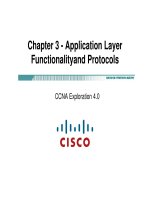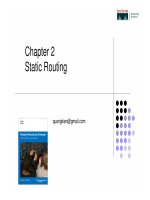Chapter 4 - Distance Vector Routing Protocols Routing Protocols and Concepts CCNA pps
Bạn đang xem bản rút gọn của tài liệu. Xem và tải ngay bản đầy đủ của tài liệu tại đây (1.12 MB, 40 trang )
Chapter 4 - Distance Vector Routing Protocols
Routing Protocols and Concepts
CCNA Exploration version 4.0
Objectives
•
•
•
•
•
Identify the characteristics of distance vector routing
protocols.
Describe the network discovery process of distance
vector routing protocols using Routing Information
Protocol (RIP).
Describe the processes to maintain accurate routing
tables used by distance vector routing protocols.
Identify the conditions leading to a routing loop and
explain the implications for router performance.
Recognize that distance vector routing protocols are
in use today
Học viện mạng Bách Khoa - Website: www.bkacad.com
2
Distance Vector Routing Protocols
•
Examples of Distance Vector routing protocols:
– Routing Information Protocol (RIP) RFC 1508
• Hop count is used as the metric
• Max hop is 15
• Routing updates are broadcast or multicast every 30 seconds
– Interior Gateway Routing Protocol (IGRP)
• Proprietary protocol developed by Cisco.
• Bandwidth, delay, load and reliability are used to create a
composite metric.
• Routing updates are broadcast every 90 seconds,
• IGRP is the predecessor of EIGRP and is now obsolete
– Enhanced Interior Gateway Routing Protocol (EIGRP)
• It can perform unequal cost load balancing.
• It uses Diffusing Update Algorithm (DUAL) to calculate the
shortest path.
• Routing updates are sent only when there is a change in the
topology. Học viện mạng Bách Khoa - Website: www.bkacad.com
3
Distance Vector Routing Protocols
•
•
Distance Vector Technology
The Meaning of Distance Vector:
• A router using distance vector routing protocols
knows 2 things:
Distance to final destination
Vector or direction traffic should be directed
Học viện mạng Bách Khoa - Website: www.bkacad.com
4
Distance Vector Routing Protocols
•
Characteristics of Distance Vector routing protocols:
– Periodic updates
– Neighbors - Routing by rumor
– Broadcast updates 255.255.255.255
– Entire routing table is included with routing update
Học viện mạng Bách Khoa - Website: www.bkacad.com
5
Distance Vector Routing Protocols
•
•
At the core of the distance vector protocol is the algorithm. The
algorithm is used to calculate the best paths and then send that
information to the neighbors.
Routing Protocol Algorithm:
- Defined as a procedure for accomplishing a certain task.
Học viện mạng Bách Khoa - Website: www.bkacad.com
6
Distance Vector Routing Protocols
• Routing Protocol Characteristics
• Criteria used to compare routing protocols includes
Time to convergence
Scalability
Resource usage
Implementation & maintenance
Học viện mạng Bách Khoa - Website: www.bkacad.com
7
Distance Vector Routing Protocols Comparison
Học viện mạng Bách Khoa - Website: www.bkacad.com
8
Network Discovery
•
Router initial start up
After a cold start and before the exchange of routing
information, the routers initially discover their own
directly connected networks and subnet masks.
Học viện mạng Bách Khoa - Website: www.bkacad.com
9
Network Discovery
• Initial Exchange of Routing Information
• If a routing protocol is configured then
•
•
- Routers will exchange routing information
Routing updates received from other
routers
Router checks update for new information
If there is new information:
•
o Metric is updated
o New information is stored in
routing table
Refer to 4.2.2.1
Học viện mạng Bách Khoa - Website: www.bkacad.com
10
Network Discovery
•
•
•
•
Exchange of Routing
Information
Router convergence is
reached when
- All routing tables in the
network contain the same
network information
Routers continue to exchange
routing information
-If no new information is found
then Convergence is reached
Refer to 4.2.3.1.
Học viện mạng Bách Khoa - Website: www.bkacad.com
11
Network Discovery
•
•
Convergence must be reached
before a network is considered
completely operable
Speed of achieving
convergence consists of 2
interdependent categories
Speed of broadcasting
routing information
Speed of calculating routes
Học viện mạng Bách Khoa - Website: www.bkacad.com
12
Routing Table Maintenance
•
•
Periodic Updates : RIPv1 & RIPv2
These are time intervals in which a router sends out its
entire routing table.
Changes may occur for several reasons, including:
– Failure of a link
– Introduction of a new link
– Failure of a router
– Change of link parameters
Học viện mạng Bách Khoa - Website: www.bkacad.com
13
Routing Table Maintenance
•
RIP uses 4 timers
– Update timer 30s.
– Invalid timer 180s.
– Holddown timer 180s.
– Flush timer 240s.
Học viện mạng Bách Khoa - Website: www.bkacad.com
14
Routing Table Maintenance
•
•
Bounded Updates: EIGRP
EIRPG routing updates are
Partial updates
Triggered by topology changes
Bounded: meaning the propagation of partial updates
are automatically bounded so that only those routers
that need the information are updated.
Non periodic
Học viện mạng Bách Khoa - Website: www.bkacad.com
15
Routing Table Maintenance
•
•
Triggered Updates
Conditions in which triggered updates are sent
-Interface changes state.
-Route becomes unreachable.
-Route is placed in routing table.
Học viện mạng Bách Khoa - Website: www.bkacad.com
16
Routing Table Maintenance
• Random Jitter
• Synchronized updates
– A condition where multiple routers on multi access LAN segments
transmit routing updates at the same time.
– Problems with synchronized updates
• Bandwidth consumption.
• Packet collision.
– Solution to problems with synchronized updates
- Used of random variable called RIP_JITTER, 0% to 15% of the
specified update interval (25 to 30 seconds for the default 30-second
interval).
Học viện mạng Bách Khoa - Website: www.bkacad.com
17
Routing Loops
• Definitions & Implications
• Routing loops are
A condition in which a
packet is continuously
transmitted within a series of
routers without ever
reaching its destination.
Học viện mạng Bách Khoa - Website: www.bkacad.com
18
Routing Loops
•
•
Routing loops may be caused by:
- Incorrectly configured static routes.
- Incorrectly configured route redistribution.
- Slow convergence.
- Incorrectly configured discard routes.
Routing loops can create the following issues
- Excess use of bandwidth.
- CPU resources may be strained.
- Network convergence is degraded.
- Routing updates may be lost or not processed in
timely manner.
Học viện mạng Bách Khoa - Website: www.bkacad.com
19
Routing Loop Issues
Routing Loop Example
• Assume for the remainder of this example that Router C’s preferred path to
network 1 is by way of Router B.
• Router C’s routing table has a distance of 3 to network 1 via Router B.
Học viện mạng Cisco Bách Khoa - Website: www.ciscobachkhoa.com
20
Routing Loop Issues
Network 1 Fails
Router E sends an update to Router A.
Router A stops routing packets to network 1.
But Routers B, C, and D continue to do so because they have not yet been
informed about the failure.
Router A sends out its update.
Routers B and D stop routing to network1, (via Router A).
However, Router C is still not updated.
To router C, network 1 is still reachable via router B.
Học viện mạng Cisco Bách Khoa - Website: www.ciscobachkhoa.com
21
Routing Loop Issues
Router C sends a periodic update to Router D
Router C sends a periodic update to Router D indicating a path to network 1
(by way) of via Router B. (4 hops).
Router D’s Routing Table information for Network 1
Current path to Network 1 = Unreachable (down)
Information from Router C: Network 1 : 4 hops by way of Router C
Normally, RouterD ignores this routing information because it usually has a
better route, 2 hops, via Router A, but this route is now down.
Router D changes its routing table to reflect this (good) better, but incorrect
information, Network 1 by way of Router C (4 hops)
Router D propagates the information to Router A.
Học viện mạng Cisco Bách Khoa - Website: www.ciscobachkhoa.com
22
Routing Loop Issues
Routers A changes its routing table
Router A adds new route to its routing table, get to Network 1 by way of Router
D (5 hops).
Propagates the information to Routers B and E.
Router B (and Router E) change their routing tables
Router B now believes it can get to Network 1 by way of Router A (6 hops).
Wow! I was about to tell Router C that Network 1 was down via Router B, but
now I have new information!
Propagates the incorrect information to Router C.
Học viện mạng Cisco Bách Khoa - Website: www.ciscobachkhoa.com
23
Routing Loop Issues
Router C changes its routing table
Router C still believes it can get to Network 1 by way of Router B (7 hops).
Of course now it believes it is 7 hops instead of 3.
Propagates the newer but still incorrect information to Router D.
Here we go again!
Data packets destined for Network 1 get caught in a routing loop, from Routers
A to D to C to B to A to D etc.
As routing updates continue between the routers, the hop count gets greater –
to infinity? (Not quite – we will see in a moment.)
Học viện mạng Cisco Bách Khoa - Website: www.ciscobachkhoa.com
24
Prevent routing loops
• Several remedies to have been added to distance-vector
algorithms to help prevent routing loops including:
– Defining a maximum metric
– Hold-down timers
– Split horizon
– Route poisoning or poison reverse
– Triggered updates
Học viện mạng Bách Khoa - Website: www.bkacad.com
25









